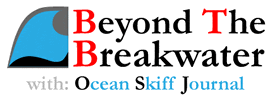This post is number 6 in our series on offshore safety in small boats. Previous posts covered: “Getting Out and Back”, “Staying Afloat“, “Man Overboard“, “Fishing Hazards“, and “Is There a Doctor in the House?“. In this post, we cover:
Being Seen
Fog and Night
Obviously, “seeing” and “being seen” are essential to avoiding a collision. During the day, with good visibility – no problem. Skiffs are so maneuverable that as long as the skiff’s operator can see a hazard, he/she can take action to avoid a collision. But what about at night, or in heavy fog?
Under these conditions, our biggest fear is getting run down by another boat. A skiff is extremely vulnerable. Reduced visibility cancels out most of a skiff’s maneuverability advantage. Since skiffs are small and sit low in the water, they are difficult to spot. Because they are often made of fiberglass or wood, they don’t show up well on radar.
We don’t have a good solution to the “seeing” part of the equation. Night vision googles improve night vision, but are limited in range. And we’re still researching usefulness in fog. Radar would be the best choice, but we’re still trying to figure out how to add it to TB2. So stay tuned on this topic.

Echomax Radar Reflector – uninflated
In the meantime, we’re using an Echomax radar reflector to address being seen in fog. Radar reflectors are devices that increase a vessel’s radar cross-section. They are attached to a high point on the boat, and make any vessel show up more clearly on radar.

Echomax Radar Reflector – inflated
Conventional radar reflectors are bulky and difficult to stow. However UK-based Echomax recently released an inflatable radar reflector. This unit is as effective as their standard radar reflectors, but folds down to a package the size of a small 3-ring binder when deflated. This is a valuable addition to our safety gear, with a minimal impact on storage
Emergencies
It is extremely difficult to spot a recreational vessel or a person in the water from any distance, even from an aircraft. The Coast Guard-required visual distress signals (VDS) are generally considered to be minimal when working offshore. The preferred choice are SOLAS-certified VDS.
What is SOLAS?
SOLAS stands for “Safety Of Life At Sea”. It is an international standard for open-ocean safety equipment. SOLAS standards for VDS are much tougher than USCG standards. This includes brightness, duration, and in the case of meteor or parachute flares, higher peak altitudes.
Why Would You Opt for USCG vs. SOLAS Signals?

Paines-Wessex SOLAS flares
SOLAS flares and smoke signals are clearly superior offshore to the equivalent USCG items. However, they are also a lot more expensive. On Toy Boat 2, our entire USCG coastal flare kit cost roughly $65.00. The equivalent SOLAS kit would cost approximately $290, and would still have to be replaced every 42 months.
As a result, we’ve chosen to stick with USCG visual distress signals. This is a calculated risk on our part. Since we are fishing near shipping lanes, usually within radio contact range of other vessels, and carry an an EPIRB (Emergency Position Indicator Radio Beacon), we feel the risk is low.
We always refresh our flares at the required intervals, but we also keep the expired flares from previous years in a separate bag. As several sources have noted, 9+ times out of 10 expired flares will ignite and burn per spec. Might as well keep them on hand as extras. The expired flares will NOT count towards the required VDS count, but it couldn’t hurt to have them around, as long as they aren’t confused with the non-expired VDS.
And Don’t Forget the Simplest Solution…

By the way, another useful emergency signaling device is the plain old signal mirror. It surprises us that not everyone carries a signal mirror in their boat. It takes up almost no room, does not expire like a flare, and is a very effective tool on sunny days. Why would you not want one as a backup for flares or other incendiary VDS?

